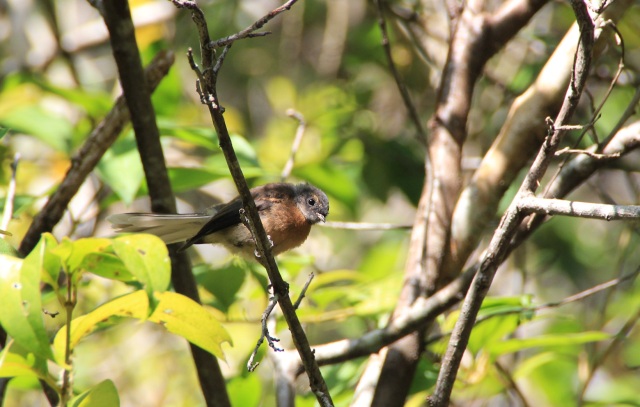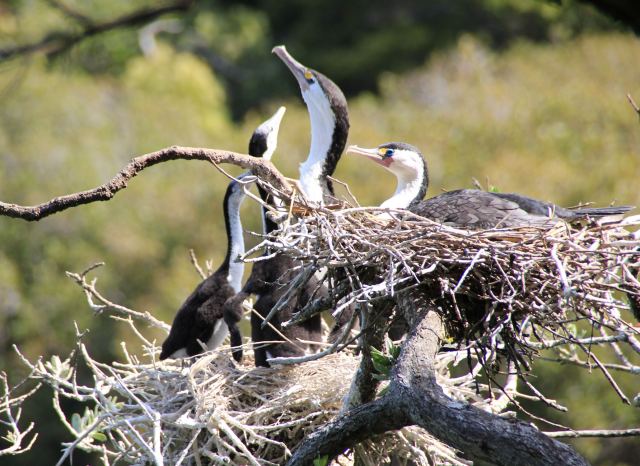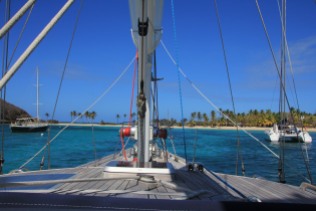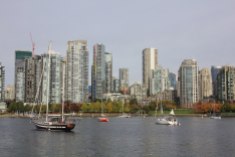On our way south from the beautiful Whangaroa Harbour we stopped at the Cavalli Islands, a group of islands just a couple of miles off the coast. We had wanted to stop here on our way up to Whangaroa from the Bay of Islands but with 25-30 knots blowing from the south west it made for pretty uncomfortable anchoring conditions on these islands. Now the wind was much lighter but with a trough of low pressure on its way we knew our time here would be limited. Our chosen anchorage at Waiiti Bay on the south west of the largest uninhabited island, Motukawanui, was already busy with numerous small power boats and a few sail boats. We had chosen this anchorage not only for its protection from a slight north easterly afternoon wind chop, but because it has a trail that leads from the beach to the north of the island which had been recommended to us.
Within a few metres of the start of the trail, we were on our own again. The hustle and bustle of the bay goers thankfully hadn’t extended into the native bush, and we were once again surrounded by bird song and the curious sound of the Chorus Cicada, a native insect that sounds like a noisy cricket.

Going one step too far with the Christmas decorations?


Looking south towards the mainland


Views north towards Whangaroa Harbour


The Department of Conservation maintain the trail and lay bait boxes and traps to catch stoat and possum, both of which have played a large part in reducing native bird numbers including the Kiwi. We aren’t on alert for signs of Kiwi as they are nocturnal, usually just enjoying the tunes and noisy wing beat of the common Tui overhead as we hike. As we entered the forested part of the trail the light faded with the thick canopy above us, we were grateful for some shade from the fierce mid afternoon sun. A small bird flitted across in front of us, as Jez stopped to see what it was I noticed a rustling of leaves on the wooded bank beside us. Expecting to see the usual culprit, a thrush or blackbird, I couldn’t believe my eyes when I saw a Kiwi! We felt very privileged as we watched for a few minutes as it rummaged around with its long needle-like bill looking for worms and bugs in the undergrowth at 3 in the afternoon, quite oblivious to us on the trail. I snapped a couple of photos, but with so much undergrowth in the way of the lens I struggled to get focus. Crouching down, I finally managed to get a shot in focus as he lifted his head, our eyes met for a second before he decided we’d seen enough and he silently waddled off into the forest like a miniature dinosaur.

I love his long whiskers and fur-like feathers
The rest of the walk, although very beautiful, paled into insignificance in comparison to our rare and wonderful sighting. As we descended the last ‘down’ to the bay where we had started the trail, we were greeted with an almost empty anchorage with just one other boat next to Joy. The wind was about to swing to the south west and increase, we were happy to stay put as conditions were still comfortable for Joy, and before long we had the anchorage all to ourselves.
Our sighting prompted me to research this incredible bird.
- There are five species of Kiwi in New Zealand, the one we saw was the North Island Brown Kiwi
- Kiwis are part of a flightless group of birds known as ‘Ratites’ and include ostrich, emu and the now extinct native moa
- The Brown Kiwi will lay one or two eggs in a burrow which are incubated by the male for 75 to 80 days
- The eggs are huge, around 20% of the females body mass, and are 6 times as big as normal for a bird of its size
- The Kiwi chick hatches fully feathered and survives its first few days on the egg sac
- The chick leaves the burrow after about 5 days and searches for food, usually never having been fed by its parents
- An adult Brown Kiwi is 50-65cm tall, females are larger than males. The one we saw was much smaller so must have been a juvenile
- Unusually, they have nostrils on the tip of their beak and have an exceptional sense of smell to help them locate food, but their eyesight is poor
- Kiwis can live to 65 years old, but the North Island Brown Kiwi’s average age is only 14 years mainly due to dogs. With no breast bone they can easily be crushed by a dogs mouth
- Two hundred years ago there were 12 million kiwis living in the native forests, by 1998 their numbers had plummeted to under 100,000. Ten years later their numbers were around 70,000, and today there are about 68,000 left. In unmanaged Kiwi areas their numbers are still declining by 2 to 3 % per year
- De-forestation and loss of natural habitat have reduced numbers, but their biggest threat is from predators such as stoats, possums and dogs
- In areas under predatory management, 50-60% of Kiwi chicks survive, in areas with no management system their survival rate is just 5%
With extinction possible in just two generations, there are numerous programs in operation to increase their numbers including a new state of the art incubating facility which can hatch and brood around 150 Kiwi chicks each year. Here they will keep the chicks until around 3 to 4 weeks old before releasing them into predator-free sites.
After our memorable stop in the Cavalli islands we headed back to the Bay of Islands to reprovision and get a few jobs done. As we sat out some windy weather anchored off of the small town of Paihia, we had a very strange evening where the sky turned sepia yellow and it went dark at just 4pm. A large cloud of smoke had arrived from the fires in Australia and had completely blocked out the sun, very eery.


Staying put in the windy weather gave us chance to get out and about and hike some of our favourite trails in the area again. In particular the Haruru Falls trail which starts near the Waitangi Treaty Grounds and follows the river upstream to the falls. It’s a nice 14 km return walk from Paihia, I like it because it’s less strenuous than the others and it has a nice selection of birds in the forest, and nesting Shags in the trees overhanging the river.



I guess this must be the ‘Shaggery’

A young Fantail

We watched this parent feed the two chicks in the nest, the youngsters head almost disappeared down the adults throat as it regurgitated its fish lunch!
The Park Ranger in this managed Kiwi area clearly has a sense of humour, we found his Stoat traps informative and funny.
We also walked a trail from Russell to the Tapeka peninsula (it was so enjoyable we did this twice in a couple of days), the views of the bay from the end of the peninsula were wonderful.






Looking out towards the entrance of the Bay of Islands

A beautiful Gannet glides gracefully past

Another flightless bird, a Weka and her baby

This strange orange bug dragged a spider up the bank, close to the top he dropped it and had to start all over again!

A Chorus Cicada spotted at last – These noisy bugs bring the forests alive with their loud chorus
We also had some great news from our preferred boat yard, Norsand in Whangarei, that they could haul us out of the water in February and keep Joy secure on land while we go back to the UK to top up our penny jar. For the first time since we have owned Joy we decided to actually visit some boat yards before we made our decision on where to haul, particularly as we will be leaving her for a few months and have a long list of maintenance jobs that need doing when we return. We had a really good feeling about Norsand, so are very pleased that they have agreed to accommodate us. We will spend most of March land traveling by car and camper van so are looking forward to a holiday from our holiday! In the meantime, on our way south to Whangarei we hope to squeeze in a bit more exploring with Joy before her well-earned rest.































How thrilling to get such a good shot of the kiwi! Such great information on them too – well done!!! Stunning scenery and lovely birds! Happy exploring!! xxxx
LikeLike
Isnât he gorgeous! Itâs a shame I didnât get a photo of the Little Blue Penguins we saw feeding in the Bay of Islands too, they were just too quick for me! I am still on the look out! Xxx
>
LikeLike